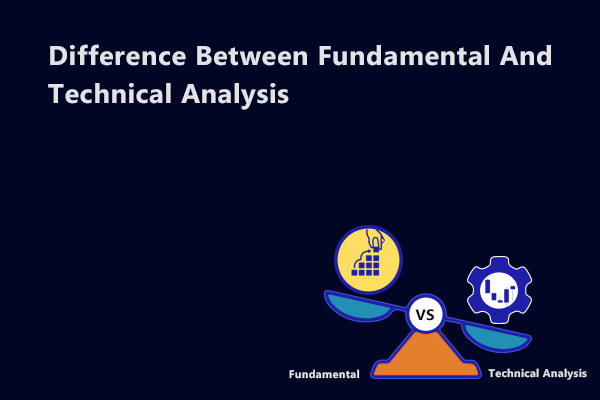
Difference Between Fundamental and Technical Analysis
When it comes to making money on the Indian stock market, it is best if you never place all your eggs in one basket. The Indian stock market can be quite volatile; it pays off if you invest carefully. How do you know when is the right time?
If you plan to invest for a longer period of time, it's important to do some fundamental research. If, on the other hand, you want to make short-term trades, look into technical indicators. This is the primary difference between technical and fundamental analysis. People can gain the essential skills to achieve good ROI through our Financial Analysis of stocks course and Technical analysis training online.
We can help you understand the difference between them.
Fundamental Analysis
Fundamental analysts focus on a company's sales, profits, and related data to determine if it is a good buy. Also called intrinsic analysis, it helps people decide if the company's services or products are beneficial to the public—and therefore worth investing in.
Technical Analysis
Technical analysis is the study of past trading activity to predict future prices. It can be used to analyze stocks, derivatives, futures, options, and currencies.
It is a method that is often used by traders and investors to make decisions about when to buy or sell a security based on price movements in the market. Technical analysts use various techniques such as charts, patterns, and volume indicators in their analysis.
The idea behind technical analysis is that there are predictable patterns of behaviour that can be found in the price movements of a security's trading history. These patterns are typically represented visually by what are called "charts."
To make it easily understandable for potential investors/beginners to take decisions, LearnNow offers Fundamental analysis of stocks and technical analysis training online.
Ten Key Differences: Fundamental And Technical Analysis
Let us see the major differences between fundamental analysis and technical analysis.:
1. The fundamental analysis method examines securities with the aim of determining their intrinsic value for investment opportunities over a long period. By contrast, the technical analysis method is estimating and forecasting the future price of a security based on changes in prices and transaction volumes.
2. Fundamental analysis focuses on a company's financial assets (study the value and future prospects of the company), whereas technical analysis focuses on a company's price (study the trends affecting the prices of stocks).
3. Fundamental analysis uses longer periods for stock analysis than technical analysis. Therefore, fundamental analysis is used by those investors who wish to invest in stocks that increase in value over the years. In contrast, use technical analysis for only short-term trading.
4. The time difference between the two analyzes is obvious not only from their point of view but also from the purposes where the technical analysis is about trading and the fundamental one is about investment. Investors tend to base their buying and selling decisions on fundamental analysis, while traders rely on technical analysis to profit in the short term.
5. The purpose of fundamental analysis is to determine the true worth of a stock, and the purpose of technical analysis is to help determine an appropriate entry or exit point in the market.
6. Fundamental analysis takes into account data from the past and present, while technical analysis only takes into account data from the past.
7. Fundamental analysis is done on the basis of financial statements and technical analysis on charts showing price movements.
8. In fundamental analysis, the intrinsic value of a stock can be determined by analyzing the income and cash flow statement, balance sheet, return on equity, profit margin, price-earnings ratio, and so on. However, technical analysts rely on charting models, technical indicators, resistance, support, and price action to analyze future price trends. Here, resistance is the point where the trader thinks the price will stop rising and is ready to sell, and support is the point where the trader thinks the price will stop falling and is ready to buy.
9. Fundamental analysis focuses on a security's past and present performance and determines its future price. Technical analysis, on the other hand, relies on price momentum (measured by trading charts and indicators) to determine future prices.
10. Fundamental analysis is carried out by a long-term trader, and technical analysis – is by a short-term day and swing trader.
Conclusion
So, it is clear that both fundamental and technical analysis have their merits. Technical analysis versus fundamental analysis is not a struggle but a general consensus on where to use the tool.
A significant difference between both is the lifetime of shareholding. The technical analysis turned out to be more beneficial for short-term investments. It has also been observed that fundamental analysis provides indicators more appropriate for long-term investments.
However, despite the difference between fundamental and technical analysis, smart investors seem to benefit from both, regardless of the investment horizon. Another difference between them is the use of mathematics. Technical analysis is more loaded with formulas and calculations.
In order to be successful, it is important to be aware of the latest developments in the financial markets. One way to stay on top of the latest trends is by enrolling in a Technical Analysis training & Financial Analysis of stocks course at LearNow.
